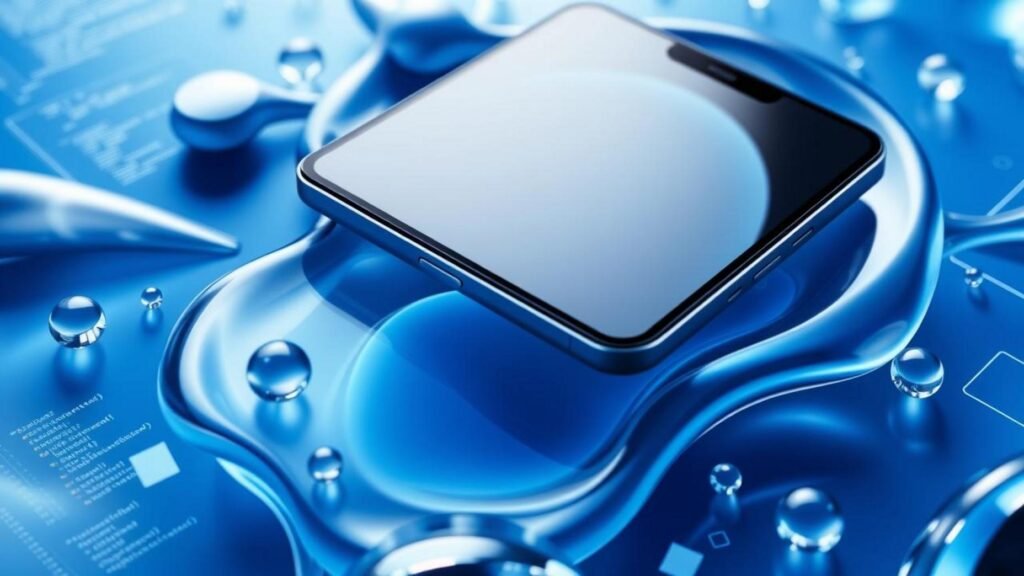Understanding Liquid Glass Design: An Overview of Its Impact on User Experience
The concept of Liquid Glass design is set to redefine the aesthetics of user interfaces, particularly with its anticipated application in Apple’s UI features showcased at WWDC 2025. This innovative design approach combines fluid, organic shapes with a glass-like appearance that offers a visually captivating experience. Unlike traditional flat designs, which can appear static, Liquid Glass introduces a sense of depth and movement. This not only pleases the eye but also makes interaction feel more dynamic and engaging.
The unique aesthetic qualities of Liquid Glass design are essential in enhancing user experience across applications. By employing transparency and layers, designers can create interfaces that provide immediate visual feedback, allowing users to see active processes and interactions in real-time. This transparency fosters a sense of connection and immediacy, making users feel more in control of their interactions with the application. For instance, elements appearing to float above a background can enhance focus on the task at hand while still providing context.
Moreover, the ineffable charm of Liquid Glass encourages users to explore more. Its captivating visuals can entice users to interact more thoroughly with each facet of an application, thereby enriching engagement metrics. This aligns closely with principles outlined in modern UI/UX design, which suggests that visual aesthetics significantly influence user retention and satisfaction. As we move toward an increasingly visual future, understanding the role of such enticing designs will be crucial for developers aiming to craft successful applications for platforms like Apple.
To further dive into how advanced designs like Liquid Glass can be integrated into your projects, consider exploring additional resources such as our guide on advanced AI technologies and their impact on user experience.
Key Features of Apple WWDC 2025 UI: Embracing the Liquid Glass Aesthetic
Apple’s WWDC 2025 has introduced a striking user interface that exemplifies the Liquid Glass design ethos. This aesthetic is not just about looks; it intertwines visual appeal with enhanced functionality, setting a new standard for user experiences across devices.
Fluid Transitions and Dynamic Effects
One of the standout features of the Liquid Glass UI is its fluid animations and dynamic transitions. Apple has leveraged advanced rendering techniques that make each interaction feel smooth and natural. These transitions often mimic the motion of liquid, providing users with a tactile sense of connection with the interface. Such fluidity enhances usability, making navigation intuitive and engaging. The subtle shimmering effects add a layer of depth to the interface, making it visually captivating and ensuring users remain interested in exploring its features.
Enhanced Transparency and Depth
The use of transparency is a signature element of the Liquid Glass design. By incorporating layers of translucent elements, Apple allows users to see through various interface components, creating a sense of depth. This design choice not only contributes to aesthetic quality but also maximizes screen real estate. Users can access information without detracting from their overall experience, making it easier to multitask and stay organized. The transparency effects can be observed in app menus and notifications, providing an unobtrusive yet functional experience where visuals meld seamlessly.
Adaptive Color Schemes
Apple’s Liquid Glass UI features adaptive color schemes that respond dynamically to user context and ambient light. This smart approach ensures that the UI remains visually pleasant and functional whether users are in bright sunlight or dimly lit rooms. The colors shift subtly, enhancing readability and comfort. Developers can customize these schemes within their applications, creating cohesive themes that align with the Liquid Glass aesthetic while catering to user preferences.
Integration with Core Technologies
The UI also deeply integrates with Apple’s core technologies like ARKit and Metal, which facilitate advanced graphics and immersive experiences. For instance, app developers can create augmented reality applications that utilize the Liquid Glass effect, rendering 3D objects with realistic reflections and colors. This capability opens new avenues for innovation in app design, allowing creativity to flourish in ways previously unimagined.
As developers explore these new features, embracing the Liquid Glass design can pave the way towards creating stunning applications that captivate and retain user attention. For an in-depth understanding of similar trends, consider reading about advancements in user experience that complement these UI innovations.
Implementing Liquid Glass Design Principles in Development: Best Practices
As Apple prepares for its WWDC 2025, developers should take note of the upcoming Liquid Glass design principles that promise to redefine the user interface (UI) landscape. Here are several best practices to ensure effective implementation of these innovative design features in your development projects.
1. Embrace Fluidity and Transparency
Liquid Glass design centers around fluidity and a sense of depth, featuring transparent elements layered with translucent colors. Developers should strive to create interfaces that mimic this smoothness by incorporating flexible layouts that adapt to user interactions. Utilizing gradient backgrounds can add depth and give a glass-like appearance to various UI components while ensuring readability and functionality.
2. Use Dynamic Shadows and Reflections
Another hallmark of Liquid Glass design is the use of shadows and reflections that dynamically change based on user interactions. Implementing CSS properties like box-shadow and filter: blur() can help simulate these effects. For a deeper understanding of effective styling techniques, consider exploring our guide on CSS Styling and SEO Optimization.
3. Optimize Touch and Motion Interactions
User experience (UX) is critical in the Liquid Glass UI paradigm. Developers should focus on creating intuitive touch and motion interactions that enhance engagement. Motion can guide users through transitions, while subtle haptic feedback can reinforce interactions, making the interface feel more responsive. Utilize frameworks like UIKit with gesture recognizers to implement these features seamlessly.
4. Prioritize Accessibility
While achieving aesthetic appeal is important, accessibility cannot be overlooked. Implement features such as voiceover support, high contrast modes, and screen reader compatibility to ensure that all users can navigate fluid interfaces with ease. Referencing the Web Content Accessibility Guidelines (WCAG) is a good starting point to enhance accessibility in your Liquid Glass designs.
5. Test Across Multiple Devices
With the diversity of iOS devices, it’s crucial to test your Liquid Glass design implementation across various screen sizes and resolutions. Consider utilizing tools like Responsive Design Mode in Browser Developer Tools to simulate how your UI adapts in different environments. This ensures a consistent user experience across all platforms.
By incorporating these best practices, developers can align their projects with Apple’s evolving design philosophy, enhancing user engagement and satisfaction. Keeping an eye on the upcoming Apple WWDC 2025 UI features will also provide further insights into refining Liquid Glass design elements in your applications.
The Future of App Design: How Liquid Glass and Apple’s UI Evolution Will Shape Developer Strategy
The introduction of Liquid Glass design in Apple’s ecosystem marks a significant turning point in app development and user experience. With its sleek, minimalist aesthetic, Liquid Glass promises to enhance visual interactions and overall accessibility. As developers look to adapt their strategies in response to these innovations, several key trends are emerging.
Integration of Dynamic Interfaces
One of the most notable future trends in app design influenced by Liquid Glass is the move towards more dynamic and fluid interfaces. Developers are encouraged to embrace motion design elements that complement the transparency and depth of Liquid Glass. This approach can lead to more immersive experiences by making UI components react responsively to user interactions. Developers aiming to leverage these capabilities should stay updated with Apple’s WWDC 2025 UI features and integration guidelines.
Enhanced Customization and Personalization
As users become more accustomed to tailored experiences, the Liquid Glass interface facilitates personalized content display. Developers should focus on utilizing machine learning algorithms to provide users with individualized recommendations and features that adapt to their usage patterns. By applying custom themes and layouts that harness the Liquid Glass aesthetic, apps can offer a more engaging user journey.
Emphasis on Accessibility
Apple’s commitment to accessibility needs to be reflected in the applications designed with Liquid Glass. With improvements in contrast and clarity that this design brings, developers must ensure that their apps are not only visually appealing but also inclusive. Implementing accessibility best practices, in line with the latest guidelines, will maximize reach and user satisfaction.
Cross-Platform Compatibility
The influence of Liquid Glass on app design extends beyond the iOS platform, pushing developers to consider cross-platform compatibility more diligently. Creating design systems that can migrate seamlessly between iOS and Android without compromising the Liquid Glass style will be crucial for increasing user base and maintaining consistency across platforms.
In conclusion, as Liquid Glass and Apple’s UI continue to evolve, developers must adapt their strategies accordingly. By focusing on dynamic interfaces, enhanced personalization, accessibility, and cross-platform capabilities, they can not only meet user expectations but also redefine what is possible in app design. For a deeper dive into advanced design trends, consider exploring AI innovations in UX or the future of AI tools here.
Sources
- Digihetu – AI Quiz App: A Step-by-Step Guide
- Digihetu – GPT 3.5 Turbo: The Ultimate Guide to Writing and Comparison
- Digihetu – n8n vs Zapier: No-Code Automation 2025
- Digihetu – XAI Grok: Revolutionizing User Experience Through Advanced AI Technology
- Digihetu – Unlocking the Power of Artificial Intelligence
- Apple – Newsroom
- Apple – WWDC 2025



